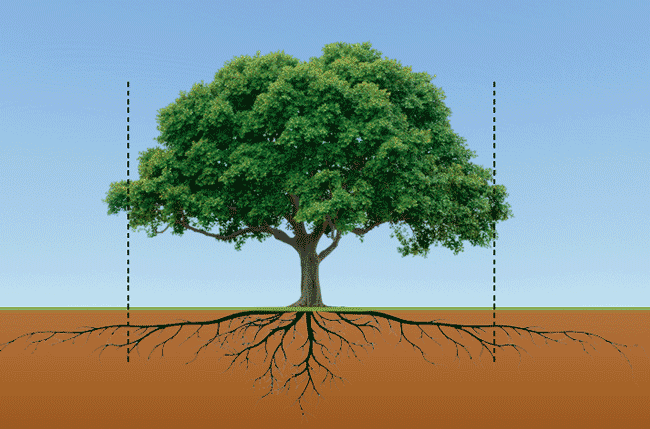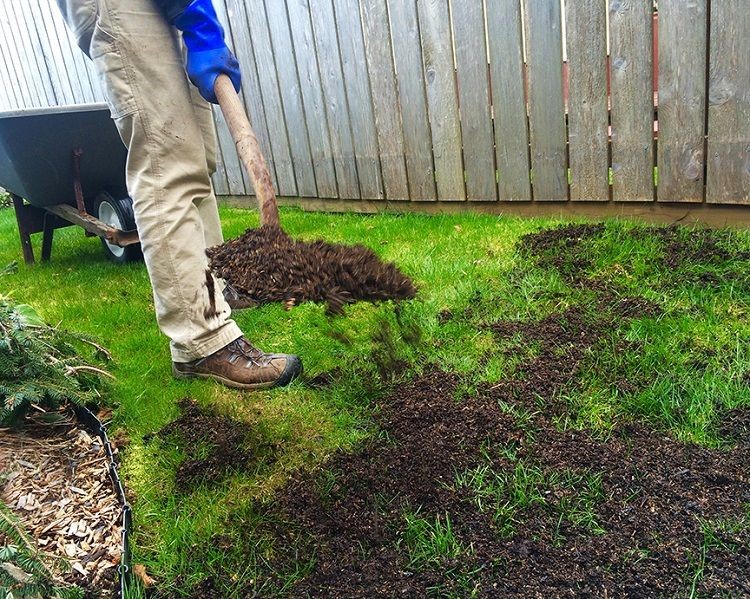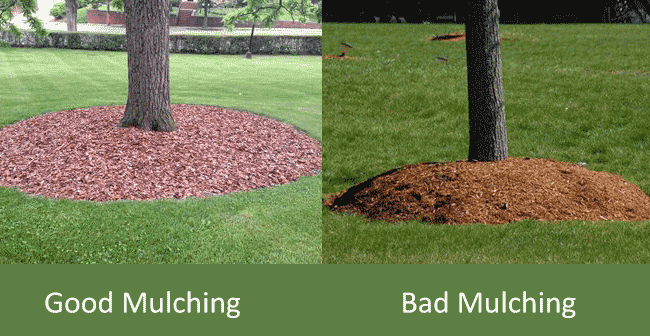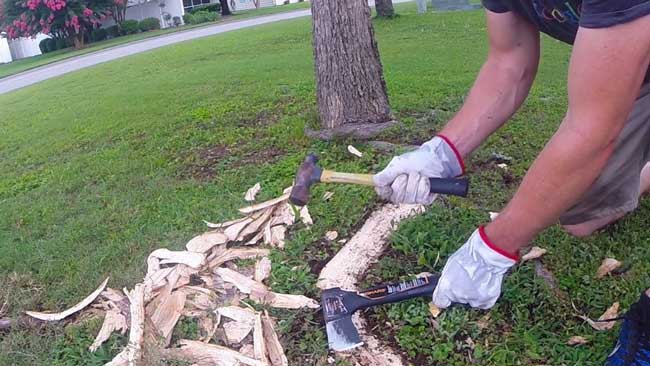The foundation of a tree’s existence indubitably lies in its roots. These serve not only as a solid base that ensures the tree remains standing, but they are also critical in supplying the tree with water and nutrients.
Removing or cutting tree roots1 above the ground can kill your tree, but at the very least will make it less structurally stable. There are instances however when roots from your trees that are outside the tree’s natural dropline can be removed as long as they are pruned by a certified arborist.
There are some other things you can do to fix the problem that doesn’t involve the removal of the roots.
What we cover
ToggleRemove surface roots outside drip line
The below image shows the drop-line of a tree that lies outside the canopy where waterfalls. Any exposed roots outside the drop-line can safely be removed as they will not affect the stability of the tree.

Tree roots come to the surface in search of oxygen and moisture. There can be many reasons for the roots to breach the surface and these can include:
- Soil erosion
- Competition between nearby tree roots
Ideally, you would be aiming to keep roots as the odds of a freshly cut root becoming infected it high, which in extreme cases can result in the decay or death of the tree.
But exposed roots can be unsightly, so if you cannot cover or hide them, there is not a lot you can, so go ahead and remove them.
If the exposed roots are inside the dropline of your tree, then there is a formula to work out how close you can prune roots to the tree trunk.
Trunk diameter x 10 = Minimum safe distance for root pruning.
So if you have a tree with a trunk diameter of 15”, the closest you can prune the roots without jeopardizing the stability of the tree is 150 inches or 12.5 feet.
Raise the surface level of your lawn
Another way to tackle the issue is to get a couple of truckloads of topsoil in to raise the surface level of your lawn.
If the roots are breaching by quite a few inches, this might have to be done in a couple of hits. Get the topsoil delivered at the start of spring.
It might have to be done over two years to give your grass a chance to grow through before you smother it with topsoil again.

Create a garden bed with mulch
Another really simple way to do it if your trees’ exposed roots are close to the trunk is to create a garden bed with mulch.
Simply order as many wood chips as you need to cover the area. Make sure the chip is no thicker than 3” or the roots will not be able to breathe or get access to water.
Spread the mulch and your problem is solved.

By building up too much mulch around the base of the tree like a volcano, you essentially trap moisture up which will eventually rot the tree’s trunk sending it toppling over.
Just cover exposed tree roots with dirt
A quick, easy, and cheap way is to cover the roots with dirt or topsoil. As long as the soil is packed down too tight to allow water and air to penetrate, it isn’t likely to cause any harm to the roots or tree.
Putting large volumes of soil or dirt over the exposed roots can reduce the supply of oxygen thus harming the trees. Try to keep the soil no thicker than 3” and you should be fine.
Mulch is definitely the best option as it breathes better than soil and is less likely to compact. Also over time as the timber greats down, nutrients are released in the form of a natural fertilizer which is going to be great for your tree.
Why do tree roots come to the surface?
Liquidambars tend to have roots that breach the surface more than others. Also, you need to bear in mind that the roots are shallower than you think and in most cases, your tree’s roots are just around 4-8 inches below the surface.
Tree roots stick close to the surface as that’s where all the water comes from. There is one that goes deeper in search of water and moisture and several feeds down, but a large majority of roots are very close to the surface.
A few reasons why roots might breach the surface:
• Soil erosion is one of the prominent reasons for the roots to surface. Rainwater and wind can erode many inches of soil in your yard and over time roots that were once below the surface start to become visible.
• If the soil in your yard is poorly drained the roots start to come above ground in search of moisture and oxygen.
• A nearby structure that has affected the tree’s natural root system can be the reason behind its surfacing.
• Trying to compact the soil for laying a lawn or altering the landscape can also cause the roots to surface.
What not to do
I have read a few other horrible blogs on what to do with surface roots. The below images show you probably the worst thing you can do to your tree roots.
Not only is this tree immediately unstable and would likely topple over in a stiff wind, but this idiot has opened up some huge wounds which are now open season for pests and diseases. It is just ridiculous.
If you do prune your roots, it should be done with a sharp cutting tool such as a pair of garden shears, a bow saw, or a chainsaw.
The root should be cross-cut like you could a branch. There are lots of other options to cover up the roots such as raiding the level of the soil/grass near the tree or installing a garden and just mulching over them.

Never do what this guy is doing above.





How do you kill tree roots in a sewer line?
If your sinks and bathtub aren’t draining properly the culprit could be tree roots. With the amount of water and nutrients flowing down the sewer lines trees, and roots are naturally attracted toward them. If you have large trees around your sewer line a tiny crack is all that the roots need to grow and wreak havoc in your plumbing.
You can start by flushing your toilet or sink with rock salt or copper sulfate. Use about a pound or so of these salts in the toilet and you should notice the difference in 12 hours or so. The salt will absorb all the moisture from the roots and trigger their death.
Repeat the process for a few days and the salts should work their magic. If the problem persists you might need to call a plumber to fix the problem.
Apart from this, you will also need to manage the tree whose roots are intruding into your sewer to prevent this problem from affecting you in the future.
How to prune exposed tree roots
There are several methods for removing exposed tree roots from the ground. Here is a great video that walks you through pruning the roots of a tree.
How do you stop tree roots from growing?
The answer to this question is simple – you can’t stop roots from growing! Most of the time this question gets asked because roots are starting to cause issues with plumbing or the foundations of your garage or home.
The best solution to manage the roots would be to install a root guard around your tree. A root guard, which is also called a root barrier, manages the growth of the roots around a tree. They come in two types –
• Solid Barriers – These are made from fiberglass, corrosion-resistant metal, or even plastic and create an impenetrable barrier around the roots of your tree. These barriers are usually installed when you want to prevent tree roots from damaging structures. However, solid root barriers often create problems in the soil’s drainage, and if you don’t choose the right size depending on the species of your tree, the roots may start to surface.
• Mesh Barriers – These are the preferred type of barriers, and as the name suggests, they are made from porous mesh screens. They prevent the larger tree roots from making it outside the wall without hindering the soil’s drainage. The chemical used in making these barriers prevents the inhibition of the large roots.
However, you must remember that root barriers can work when installed on time, and you choose the right type and size of the barrier for your trees. Making the wrong choice can restrict your trees from developing a healthy root system.
You will also need to prepare the soil before installing root barriers. It would be wise to consult an arborist and take their suggestion in making the right choice.
Can I cut my neighbour’s tree roots?
Fundamentally a tree belongs to the person on whose property it grows. There are scenarios where your neighbor’s tree encroaches upon your property.
While dealing with neighbors overhanging branches is easy, but the same isn’t the case with the roots. As a property owner, you are entitled to remove those branches that have encroached on your property and cut them back to the boundary.
Legally speaking you don’t need to seek permission from your neighbor before you chop the roots of their tree, but it would be wise to inform them about your concerns first.
There are a few things you need to keep in mind before starting.
1. First chopping off the roots beyond the boundary may be considered as an act of trespass.
2. Secondly, there is always a danger of killing a tree or making it unsafe when you mindlessly start chopping off the roots.
Hiring a certified arborist would be the best way to go as they will use their scientific knowledge to identify which roots are able to be cut and which must stay.
This will prevent damage to your property and at the same time, you won’t cause any harm to the tree. It’s important to know where you stand in case a neighbor’s tree roots damage your property.
Do tree roots die when you cut down a tree?
It all depends on the species of the tree you are cutting down. There are certain species of trees where roots won’t produce any sprouts once the tree has been cut down. It’s a bit of a survival mechanism for them.
In most cases, though the roots beneath the ground would slowly decompose after the tree stump had been removed and in some cases, you’d notice the ground above the large roots sinking a little.
If you have a tree prone to sprouting suckers such as willow, camphor, poplar, plane tree, and other “invasive” species, you will need to use a herbicide such as Round-Up to try and kill the root system before it gets out of control.
You can also opt for other types of chemicals such as Epsom salts, but such decisions need to be taken by an arborist. The risk of poisoning the soil and causing harm to your lawn and other trees in the vicinity is high.
- Davey Blog, (2021) Removing Tree Roots Above Ground: Will It Harm or Kill the Tree? <https://blog.davey.com/removing-tree-roots-above-ground-will-it-harm-or-kill-the-tree/> Accessed: 05-03-2024



